Why this resume works
- Quantifies accomplishments: By mentioning resume accomplishments such as achieving a 10% cost reduction and ensuring 100% safety compliance, the applicant illustrates their impact in concrete terms.
- Showcases career progression: Starting as a laborer and advancing to construction worker reflects their career growth, with increasing responsibilities like supervising crews and reducing project timelines.
- Uses action-oriented language: Action verbs such as “installed,” “reduced,” and “ensured” convey initiative and effectiveness, demonstrating proactive contributions.
More Construction Worker Resume Examples
Our construction worker resume examples show how to emphasize your hands-on experience, teamwork, and safety skills. Use these samples to design a strong resume tailored to construction roles.
Entry-level construction worker
Why this resume works
- Effective use of keywords: By incorporating industry-specific terms such as “blueprint interpretation” and “safety compliance,” the applicant leverages keywords to navigate ATS effectively.
- Shows technical skills: The resume mentions safety compliance and blueprint interpretation, showcasing the applicant’s readiness for construction work.
- Centers on academic background: Highlighting a bachelor’s in civil engineering shows that the applicant’s foundation early in their career comes from their higher education.
Mid-level construction worker
Why this resume works
- Points to measurable outcomes: By completing projects 10% faster and reducing material waste by 15%, the applicant’s impact-driven results speak volumes about their efficiency and contributions to construction projects.
- Includes a mix of soft and hard skills: Mixing project management with interpersonal skills, the applicant combines technical know-how with team leadership, ensuring site safety compliance and effective teamwork.
- Displays technical expertise: Armed with certifications like OSHA 30-Hour Construction Training and expertise in blueprint interpretation, the applicant showcases a strong foundation of technical skills essential for construction roles.
Experienced construction worker
Why this resume works
- Focuses on work history: By using a chronological resume, the applicant organizes extensive work history effectively, emphasizing career growth and long-term contributions across roles in construction management.
- Showcases impressive accomplishments: Including measurable achievements like expanding team productivity by 25% and completing projects under budget reflects senior-level impact.
- Sections are well-organized: Headers and concise bullet points ensure sections are easy to scan, allowing readers to quickly grasp key qualifications, certifications, and accomplishments without overwhelming detail.
Construction Worker Resume Template (Text Version)
Daniel Lee
Jacksonville, FL 32204
(555)555-5555
Daniel.Lee@example.com
Professional Summary
Experienced Construction Worker skilled in project management, safety compliance, and enhancing efficiency. Proven track record in delivering projects under budget with excellent team leadership.
Skills
- Project Management
- Safety Compliance
- Blueprint Reading
- Tool Operation
- Team Leadership
- Quality Control
- Time Management
- Technical Communication
Certifications
- Certified Construction Manager – Construction Management Association of America
- OSHA Construction Safety – U.S. Department of Labor
Education
Master of Science Construction Management
Nevada Institute of Construction and Engineering Reno, Nevada
May 2019
Bachelor of Arts Civil Engineering
California State University San Bernardino, California
May 2017
Work History
Construction Worker
BuildRight Construction – Jacksonville, FL
June 2023 – June 2025
- Installed systems with 95% accuracy
- Reduced project costs by 10%
- Ensured safety compliance 100%
Site Technician
SolidBase Developments – Riverview, FL
June 2020 – May 2023
- Supervised crew, completing projects 15% faster
- Trained 5 new hires in safety protocols
- Assisted in layout design enhancements
Construction Laborer
Prime Build Solutions – Jacksonville, FL
June 2019 – May 2020
- Handled tools, reducing injury incidents
- Contributed to project efficiency by 8%
- Supported senior workers in tasks
Languages
- Spanish – Beginner (A1)
- French – Intermediate (B1)
- German – Beginner (A1)
Related Resume Guides
Advice for Writing Your Construction Worker Resume
Learn how to write a resume for a construction worker position and how to highlight your building skills, work ethic, and dedication. Whether you’re laying foundations or finishing interiors, learn how to craft a standout resume that showcases your expertise in the construction field.
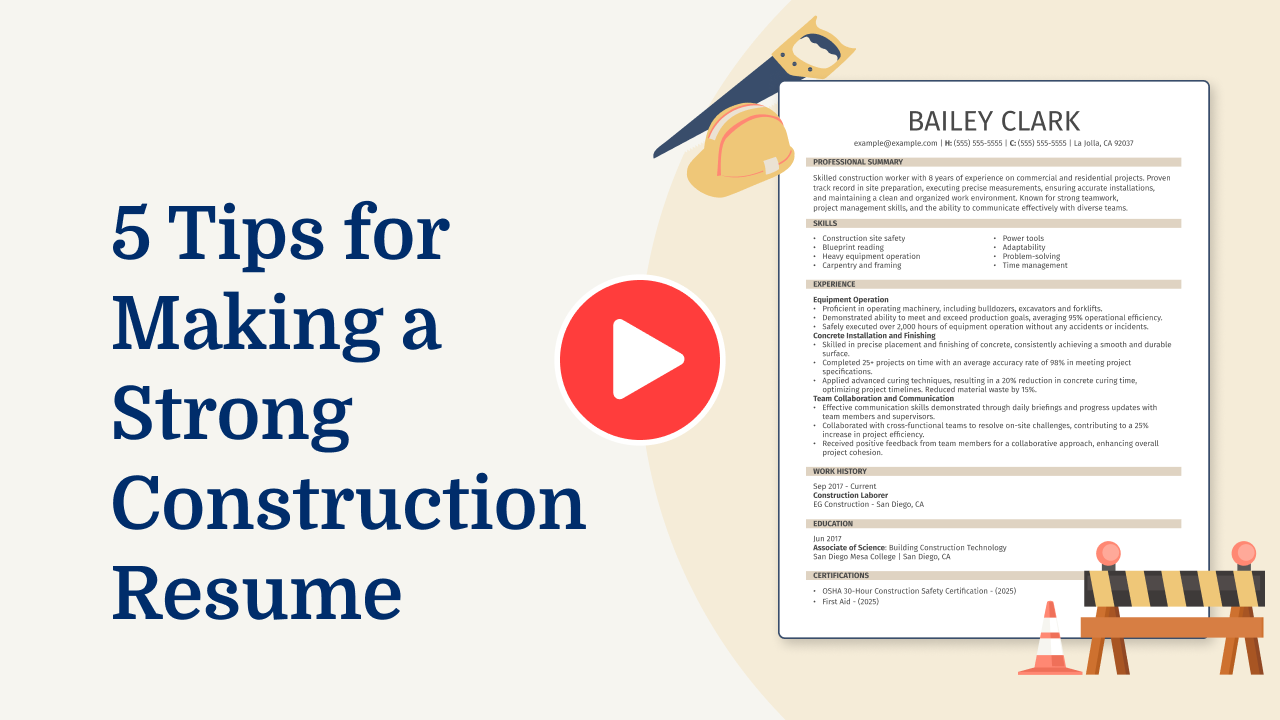
Highlight relevant technical skills
For a construction worker, technical skills help you do your job well and safely. Help employers see that you have the know-how they need by making a separate section on your resume just for technical skills, or including them in your work experience section to show how you use them on the job.
Some common technical skills for construction workers include:
- Using power tools like drills and saws
- Reading blueprints
- Understanding building codes
- Knowing how to operate heavy machinery like forklifts or cranes
Having these skills means you can handle different tasks on a construction site. When listing these skills, use simple words and be specific about what you can do. For example, instead of just saying “good with tools,” say “experienced with hand and power tools.” This way, employers get a clear picture of what you’re capable of doing on the job site.
Example of a technical skills section
- Construction machinery operation (excavators, bulldozers, cranes)
- Blueprint reading and interpretation
- Concrete mixing and pouring techniques
- Woodworking tools and carpentry skills
- Electrical wiring and installation basics
- Plumbing systems installation and repair
- OSHA safety regulations compliance
- Power tools usage (drills, saws, grinders)
- Surveying equipment handling (transits, levels)
- Basic welding and metal fabrication
Don’t forget soft skills! Teamwork, communication, and adaptability are just as important as technical skills in many jobs.
Quantify your accomplishments
Quantifying accomplishments in your resume makes it stand out by showing what you have achieved, not just what you did. For a construction worker, listing specific results can make a big difference.
In your work experience section, start with your job title, the name of the employer, location, and dates of employment. Then focus on turning duties into achievements. For example, instead of saying “helped build houses,” say “completed construction of 10 houses three weeks ahead of schedule.” This shows not only what you did but also how well you did it.
Using numbers like percentages or time savings highlights your impact. By quantifying your successes, you show the skills and impact you’ve had in clear terms. This helps potential employers see exactly what benefits you bring to their projects.
5 construction worker work history bullet points
- Operated heavy machinery such as bulldozers and cranes, increasing site productivity by 25%.
- Assisted in the construction of 10+ residential buildings, ensuring projects were completed on time and within budget.
- Collaborated with a team of 20 workers to successfully complete a $2 million commercial project ahead of schedule.
- Implemented safety protocols that reduced on-site accidents by 40%, fostering a safer working environment.
- Maintained tools and equipment for optimal performance, decreasing repair costs by 15% over one year.
Need help with your resume? Check out professional resume examples to get ideas and make yours shine!
Write a powerful professional summary
A professional summary on a resume introduces hiring managers to your background, grabbing their attention from the start. When putting together your resume, you can choose between writing a professional summary or a resume objective. Each serves its own purpose and addresses different needs.
A professional summary usually consists of three to four sentences that highlight your experience, skills, and achievements. It’s perfect for experienced construction workers who want to emphasize their professional identity and show potential employers their value. The aim is to make an impact by summarizing what you’ve achieved in your career.
On the other hand, resume objectives outline your career goals and are great for those new to the workforce, switching careers, or dealing with employment gaps. While summaries focus on “what I’ve accomplished,” objectives stress “what I aim to contribute.” Both play unique roles but help guide readers through your professional journey.
Next, we’ll look at examples of both summaries and objectives tailored for various levels of experience.
Construction worker resume summary examples
Entry-level
Recent graduate with a diploma in construction technology, hands-on training in carpentry and masonry. OSHA 10 certified and familiar with basic safety protocols on construction sites. Eager to contribute a strong work ethic and foundational skills to support building projects and learn from experienced team members.
Mid-career
Skilled construction worker with over seven years of experience in residential and commercial projects. Proficient in operating heavy machinery, interpreting blueprints, and executing quality finishes. Known for completing tasks efficiently while maintaining high safety standards. Successfully collaborated on multiple high-profile developments.
Experienced
Seasoned construction worker with 15+ years of expertise in large-scale infrastructure projects. Experienced crew leader adept at managing teams, overseeing project timelines, and ensuring adherence to strict safety regulations. Specialized in concrete work and steel framework with a track record of improving site productivity through strategic planning.
Construction worker resume objective examples
Entry-level
Hardworking and reliable individual seeking an entry-level construction worker position to apply hands-on skills and knowledge of basic tools, safety practices, and physical labor. Eager to contribute to building projects while gaining valuable experience in the construction industry.
Career changer
Detail-oriented professional transitioning into construction work with a background in warehouse operations and equipment handling. Looking to bring transferable skills such as teamwork, time management, and mechanical aptitude to a growing construction team while learning new techniques on-site.
Recent graduate
Dedicated recent high school graduate aiming to build a career in construction by joining a dynamic team as an entry-level worker. Committed to applying strong work ethic, adaptability, and willingness to learn toward assisting in successful project completion.
Choose a clean and simple resume template with clear sections to make it easy to read. Avoid flashy colors or fonts that might distract from your skills and work history.
Showcase your credentials
Listing your credentials as a construction worker is important because it shows you have the right skills and training for the job. Certifications, licenses, and specialized training tell employers you know how to do tasks safely and correctly.
They are especially important in technical fields like construction, where safety and precision matter a lot. Creating a dedicated certifications section on your resume helps these stand out and can be a good addition to your credentials.
Some popular certifications for construction workers include:
- OSHA 10-Hour Construction Safety
- CPR and First Aid Certification
- NCCER Certified Construction Worker
- Forklift Operator License
- Scaffolding Safety Certification
Having these certifications can help you succeed as a construction worker by showing employers you’re ready for the job. They demonstrate that you’ve learned key skills and understand industry standards, making you more memorable to potential employers.
Example of a certifications section
OSHA 30-Hour Construction Safety Certification
Issued by: Occupational Safety and Health Administration (OSHA)
Issued 2023
CPR and First Aid Certification
Issued by: American Red Cross
Expires 2026
Certified Forklift Operator
Issued by: National Safety Council (NSC)
Issued 2022
Construction Quality Management for Contractors
Issued by: U.S. Army Corps of Engineers
Issued 2021
Confined Space Entry Training
Issued by: National Association of Safety Professionals (NASP)
Expires 2025
Include either the issue date or expiration date of each of your certifications and licenses to show that your credentials are current.
FAQ
Do I need to include a cover letter with my construction worker resume?
Yes, including a cover letter with your construction worker resume can make a positive impression on potential employers.
A cover letter gives you the chance to highlight your hands-on skills and experience in specific projects that align with the job description.
For instance, if the company specializes in residential building or commercial projects, you can emphasize your relevant experience or interest in those areas.
You might consider using tools like a Cover Letter Generator to easily craft a personalized cover letter or explore sample templates for inspiration.
Additionally, reviewing cover letter examples of construction-oriented cover letters can provide insight into effective ways to convey your enthusiasm and suitability for the role.
How long should a construction worker’s resume be?
For a construction worker, a one-page resume is usually enough to highlight your skills and experience effectively. Focus on key competencies like safety management, equipment operation, and any specialized training or certifications you have.
If you have extensive experience or additional qualifications that are particularly relevant, stretching to a two-page resume might be appropriate. Just make sure each detail adds value by showing your ability in important tasks like project execution and teamwork.
Consider exploring our guide on how long a resume should be for more examples and tips tailored to your career stage.
How do you write a construction worker resume with no experience?
If you’re looking to create a resume with no experience as a construction worker, highlight your skills, education, and any relevant training that show you’re ready for the job. Here are some tips for an entry-level construction worker resume:
- Highlight transferable skills: Emphasize physical stamina, ability to follow instructions, teamwork, problem-solving skills, and reliability. These are important in construction and can come from various experiences like sports or volunteer work.
- Include relevant education or training: List any courses or certifications related to construction or safety procedures. If you’ve completed OSHA training or workshops related to tools and machinery, make sure these stand out.
- Mention hands-on experience: Even if it’s not professional work, include any DIY projects or volunteer activities where you used construction skills. Detail what tasks you performed and the outcomes achieved.
- Showcase soft skills: Communication and organizational abilities are important on-site. Highlight instances where you’ve demonstrated these skills effectively in previous roles or projects.
Consider checking out resources specific to entry-level resumes for more detailed examples and strategies tailored by professional career advisors.
Rate this article
Construction Worker
Additional Resources
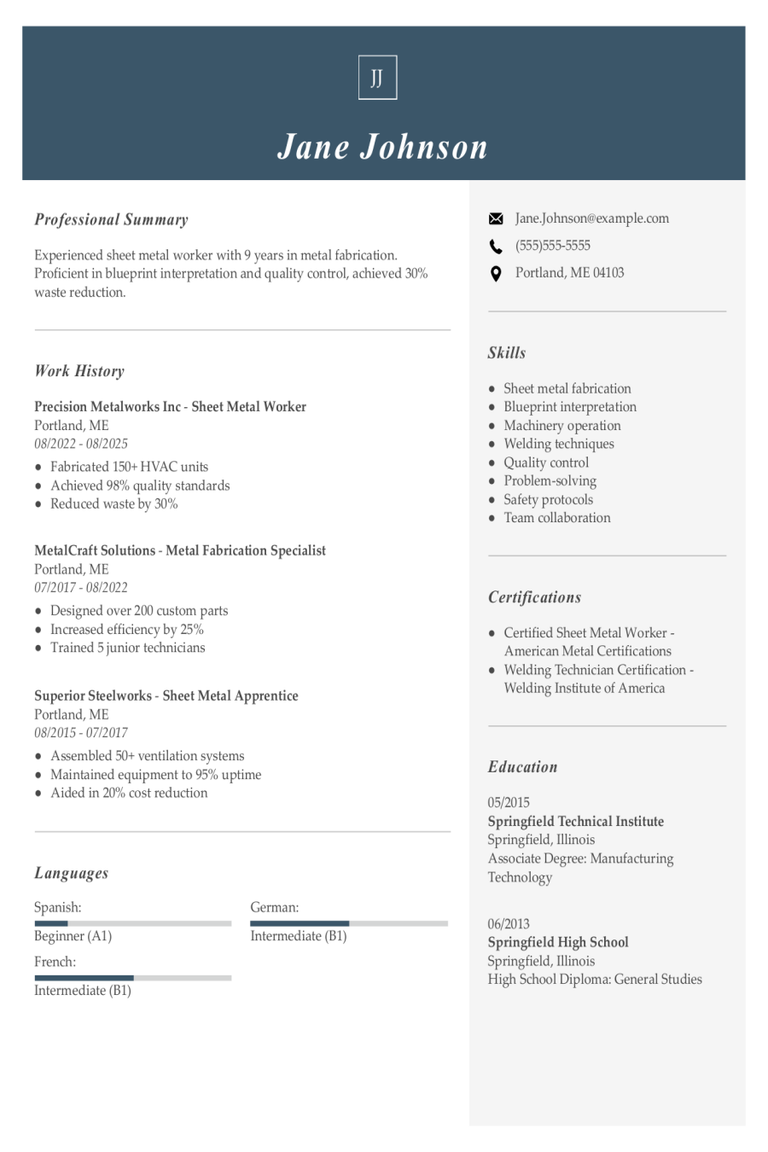
Sheet Metal Worker Resume Examples & Templates for 2025
Browse sheet metal worker resume examples and tips to learn how to highlight your hands-on experience and problem-solving abilities to stand out to recruiters and hiring managers.Build my resumeImport existing

Job Title Inflation: 92% of Workers Say Job Titles Are Used to Fake Career Growth
Job titles are supposed to signal achievement. However, for many employees, they’ve become nothing more than a brand. A new MyPerfectResume survey of 1,000 U.S. workers reveals that job titles are
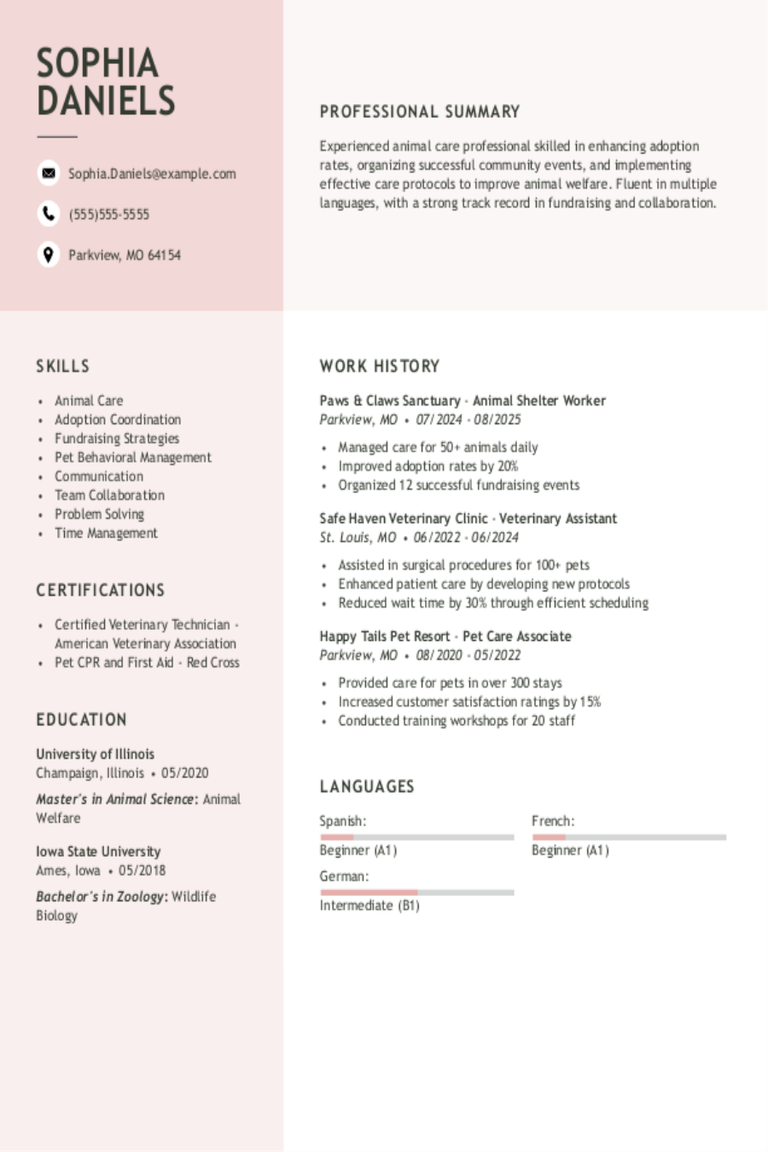
Animal Shelter Worker Resume Examples & Templates for 2025
Explore animal shelter worker resume examples to see how to highlight your experience caring for animals, maintaining facilities, and assisting with adoptions. These samples and tips help you highlight compassion,
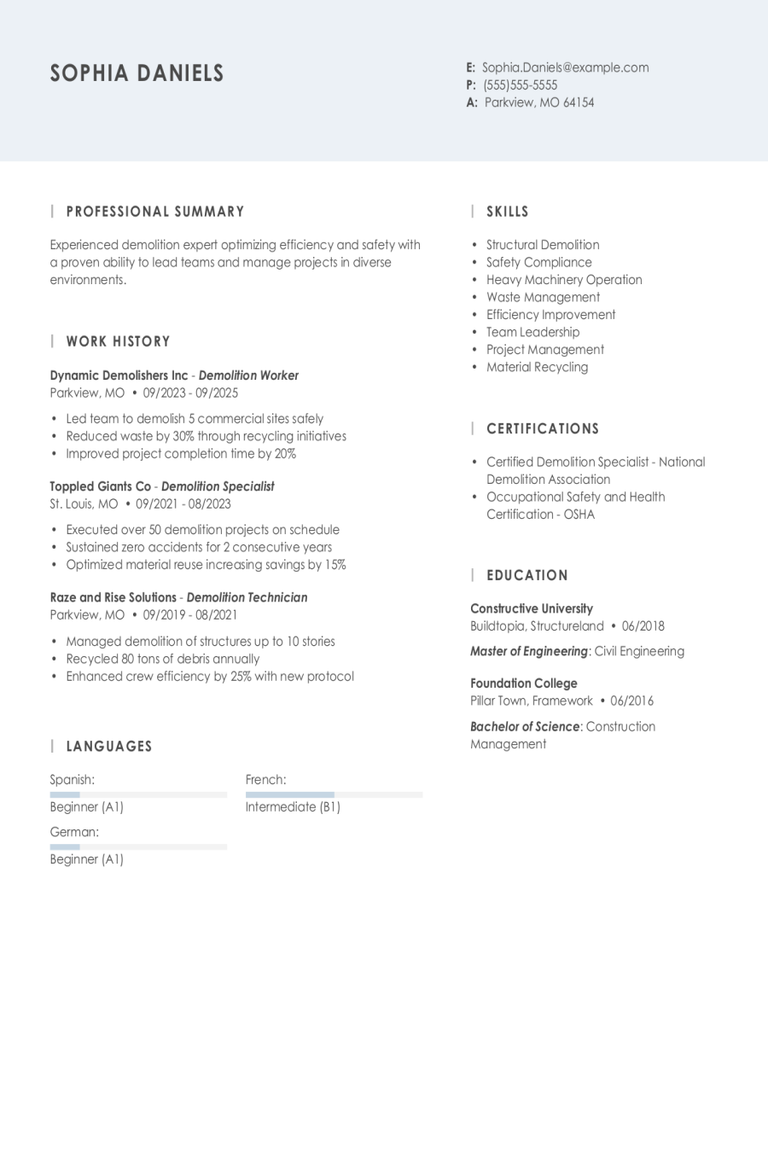
Demolition Worker Resume Examples & Templates for 2025
Discover demolition worker resume examples that highlight skills in safely tearing down structures and handling heavy equipment. Learn how to showcase your experience and catch the eye of construction employers

Ghost Growth: 65% of Workers Say Their Career Growth Is Just for Show
Career growth is supposed to feel empowering. But for millions of U.S. workers, it feels fake. A new MyPerfectResume survey of 1,000 currently employed adults reveals that most workers have experienced
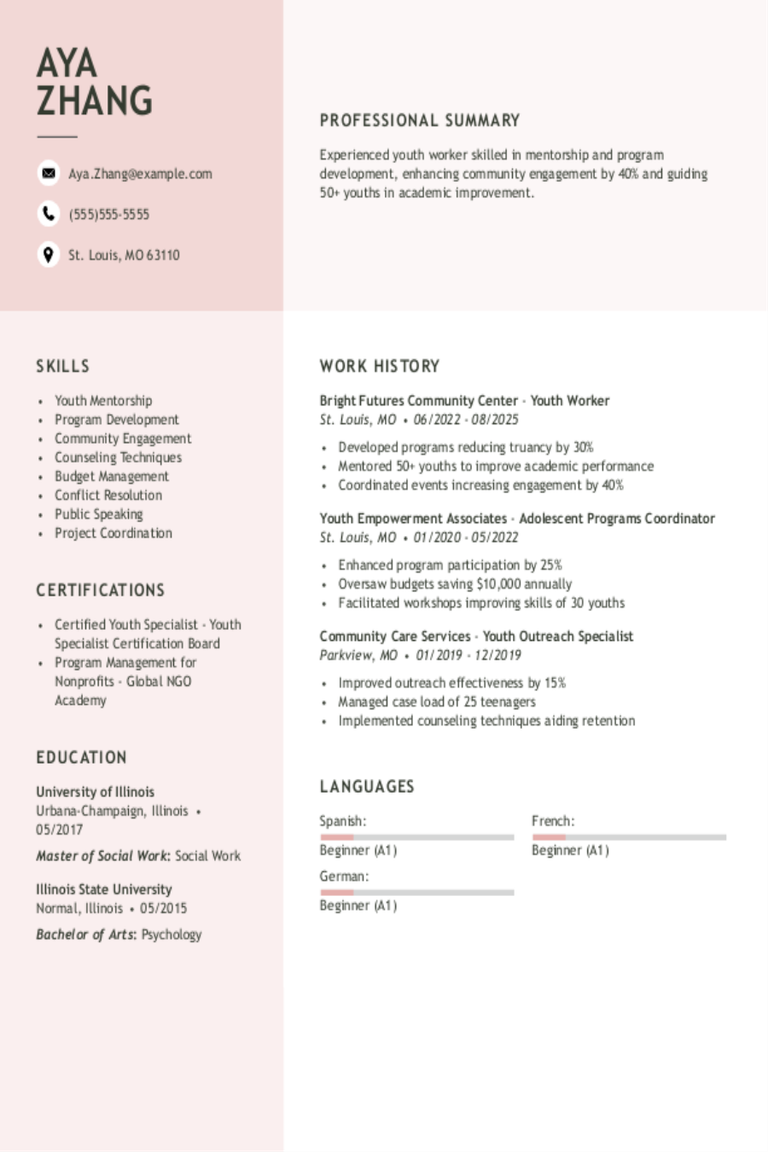
Youth Worker Resume Examples & Templates for 2025
Browse youth worker resume examples and learn how to highlight your ability to connect with young people, organize activities, and make a positive impact in their lives.Build my resumeImport existing
